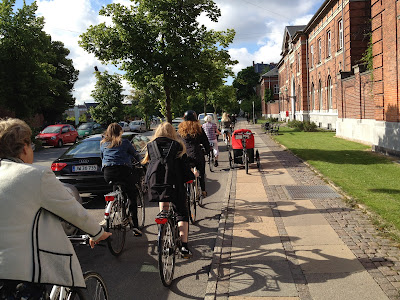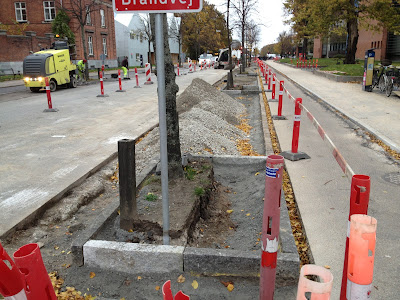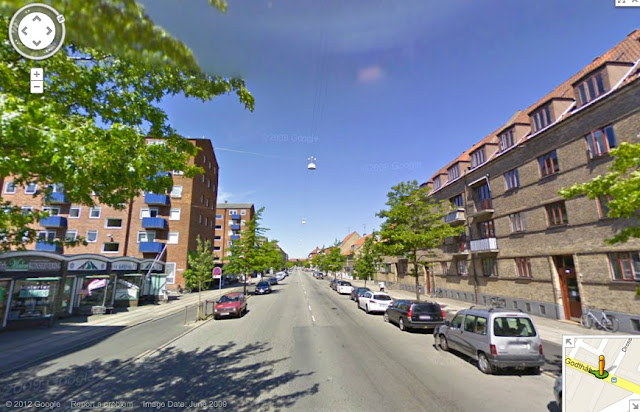
The key is to question the status quo, every time a street needs surface renovation. A quick assessment of traffic numbers by modality, and speed of cars, the nature of the street in the traffic system and urban usage, will provide a little insight to make improve how we utilize our city.
 |
| Morning Traffic at Nørre Allé -The picture was taken during the central summer holiday season, where commuter-traffic is at its lowest. |
In this case, the street, Nørre Allé (Northern Avenue) is surrounded by the campus of Copenhagen University School Medicine, a retirement home campus (The City of the Old), a church and 5-storey residential buildings. At the end of the street a small plaza is situated, Skt Hans Torv, which has a number of very popular Cafés, not least in summer time.
The neighbourhood, Nørrebro, has the least car-ownership in Denmark, only 13% of locals owns a car or has access to a company car.
The street has about 5.000 cars daily, 7.500 bikes and likely around 1.000 pedestrians, but the latter is rarely measured. The road serves small nearby streets, but is not part of cross town traffic (South of Tagensvej).
 |
| Current street profile |
The Street is twelve meters wide, including streetside trees, which have curbside parking in between. Parking in both sides takes up 4 meters, which leaves 8 meters for car lanes. There is no bus service in the street and as the speed limit is 50 km/h, two time 2,3 meters is sufficient for lane width. Meanwhile the bike lane is only two meters, which is insufficient for the traffic, taking into account 90 cm wide cargo bikes are widely used by the local population, likely the highest cargo-bike usage in the world (outside The Netherlands for sure). The usual picture cars takes up a disproportionate share of the city space.
By narrowing the car lanes from 8 to 6 meters, the bike lane can be widened to 3 meters each way. This means the streetside trees will actually be in the bike lane, but, this can work fine, as the picture from Godthåbsvej, Frederiksberg shows, in between the trees pockets which allows plenty of space to pass slower bicyclists and cargo bikes.
 |
| On this side of the street, heading north, the bike path could generally easily have been widened 75 cm to 1.25 m |
 |
| On this side of the street, heading South, the bike path could generally not have been widened, but given an extra meter between the trees. |
Please note that with this solution, there are not just the same amount of parking spaces, there will actually be around fifteen to twenty more, in addition the solution could have been done within the budget constraints of the current surface maintenance of the street. The extra space comes from the very wide car lanes, which are still 25% wider, than necessary for the amount of car traffic and the speed limit.
The solution above is the way Frederiksberg chose to give better bicyclist mobility, at the expense of none!
Now if we did have a little extra money, we could narrow the car lanes to the minimum requirement to the speed limit and traffic volume, this would allow
1.4 meters for a central reserve.
The central reserve could be a flowerbed for field flowers and grasses, needing little care and maintenance, and even an extra line of trees down the middle of the road (this option would cost extra though). In Copenhagen city planners have a strange addiction to cobblestone, and would most likely prefer to lay expensive cobblestone, which makes road, sewage and utilities maintenance much more costly.
The trees would even be free, as there is currently a large volume of abundant trees in the city, as current metro construction forces a series of trees in streets and plazas to be removed.
 |
| Profile with Central Reserve, this design reduces all possible motivation for cars to speed, and creates an intimate greener more CO2 consuming streetprofile |
As mentioned the traffic volume is low and primarily commuter traffic to and from the campus an nearby-streets, it would be no great sacrifice to make it one-way, which would allow for a better bike lane on the outside of the trees in one side of the road, and as importantly a really nice wide sidewalk on one side of the street.
This last solution, would require an additional budget for the sidewalk, and that was not really the point of this blog post, but
Anything but the status quo would make the street much better. Narrower car-lanes and an extra line of trees, would lower speeds, and make the street much more accessible for pedestrians and bicyclists, without limiting car mobility or parking.
Questioning the status quo is profitable, neglecting to is irresponsible abuse of taxpayers money.







